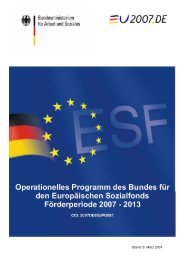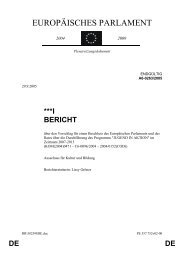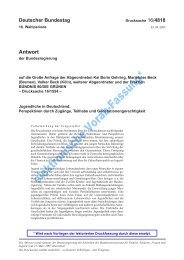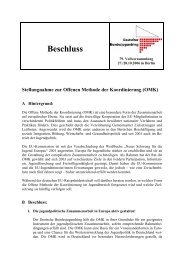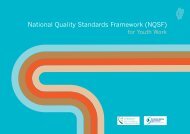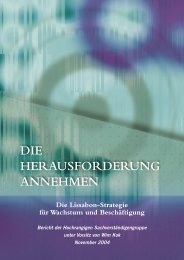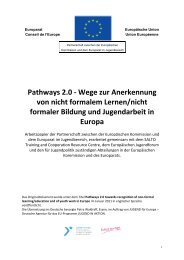Report - Salto
Report - Salto
Report - Salto
Create successful ePaper yourself
Turn your PDF publications into a flip-book with our unique Google optimized e-Paper software.
Bridges for Recognition | Terms and Concepts - What do we mean when we say…<br />
49<br />
Types of Learning<br />
Formal learning is purposive learning that takes place in a distinct and institutionalised<br />
environment specifically designed for teaching/training and learning, which is staffed by<br />
learning facilitators who are specifically qualified for the sector, level and subject concerned<br />
and which usually serves a specified category of learners (defined by age, level and specialism).<br />
Learning aims are almost always externally set, learning progress is usually monitored and<br />
assessed, and learning outcomes are usually recognised by certificates or diplomas. Much<br />
formal learning provision is compulsory (school education).<br />
Non-formal learning is purposive but voluntary learning that takes place in a diverse range of<br />
environments and situations for which teaching/training and learning is not necessarily their<br />
sole or main activity. These environments and situations may be intermittent or transitory,<br />
and the activities or courses that take place may be staffed by professional learning facilitators<br />
(such as youth trainers) or by volunteers (such as youth leaders). The activities and courses<br />
are planned, but are seldom structured by conventional rhythms or curriculum subjects. They<br />
usually address specific target groups, but rarely document or assess learning outcomes or<br />
achievements in conventionally visible ways.<br />
Informal learning: from the learner’s standpoint at least, this is non-purposive learning<br />
which takes place in everyday life contexts in the family, at work, during leisure and in the<br />
community. It does have outcomes, but these are seldom recorded, virtually never certified<br />
and are typically neither immediately visible for the learner nor do they count in themselves<br />
for education, training or employment purposes. APEL systems are one way in which the<br />
outcomes of such learning can be made more visible and hence open to greater recognition.<br />
Open and distance learning (ODL) combines two distinct categories of learning provision and<br />
participation which frequently occur together. Open learning is purposive learning that takes<br />
place where, when and how the learner chooses. It may also be self-directed learning, that is,<br />
the learner also voluntarily chooses what and why to learn. Open learning may be formal or<br />
non-formal in character. Distance learning covers the spectrum from correspondence learning<br />
(‘by post’) to eLearning (IT supported learning, whether as content, pedagogy or medium). It<br />
may or may not be designed as open learning, and can include highly formalised and closely<br />
assessed types of learning processes and outcomes.



